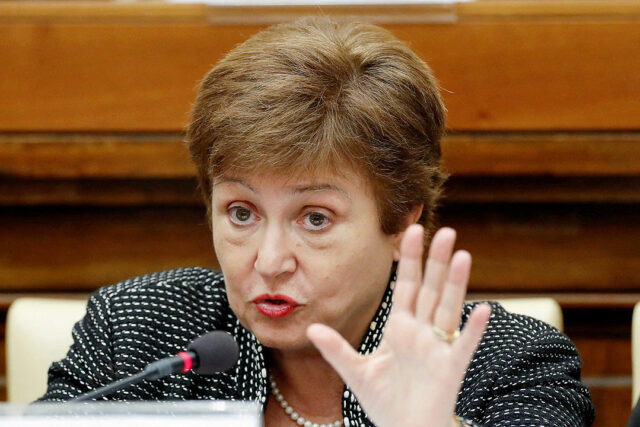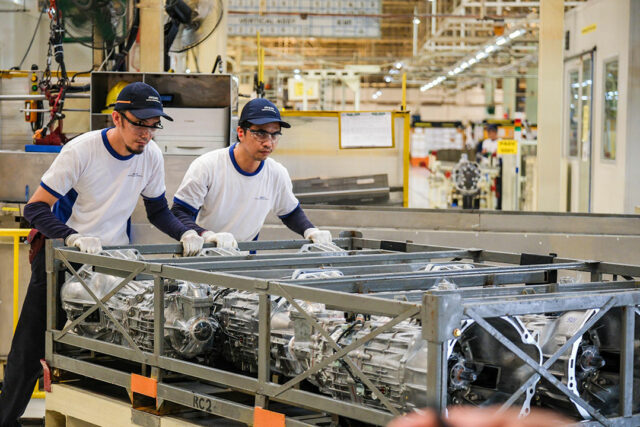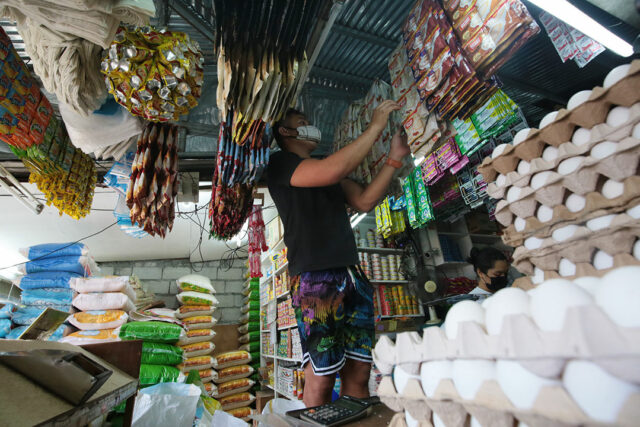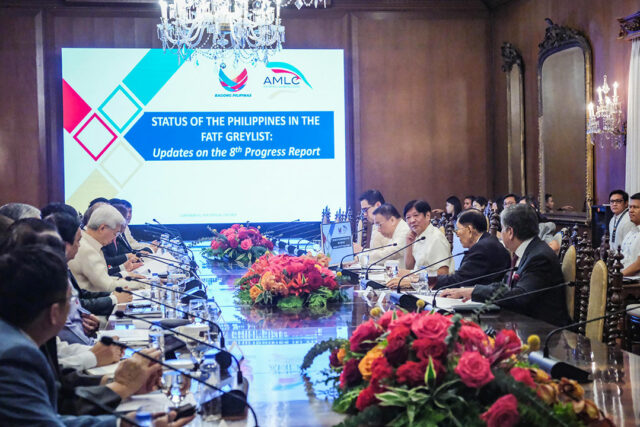By Kyle Aristophere T. Atienza, Reporter
LILY G. TERRENIO was 19 years old when she became a factory worker at Amertron, Inc. inside the Clark Freeport Zone north of the Philippine capital in 1988.
The high school graduate worked for the Taiwan-owned semiconductor company until 2000, before leaving for Dubai to work as a chambermaid.
“I would have wanted to join a different manufacturer after I left the company to broaden my experience, but options were limited,” she said in an interview.
Ms. Terrenio came back to the Philippines after two decades, when the manufacturing sector contracted by 9.8% from a year earlier amid a coronavirus pandemic.
The government must rescue the manufacturing sector from issues that have stalled growth including the lack of skilled workers, governance problems and an impending energy crisis that could paralyze the economy, analysts said.
“Philippine manufacturing has been on a retreat since the 1980s,” national scientist Raul V. Fabella, a professor emeritus at the University of the Philippines School of Economics said in an e-mail. “The share of manufacturing in Philippine gross domestic product has been losing out to services.”
He called the phenomenon “development progeria,” which happens in low-income economies when the share of industry sectors including manufacturing falls while services flourish. “The dynamics will continue into the near future because its roots are structural.”
Manufacturing activity in the Philippines continued to expand in December, albeit at a slower pace, S&P Global said on Tuesday. The S&P Global Philippines Manufacturing Purchasing Managers’ Index (PMI) slipped to 51.5 in December, from a nine-month high of 52.7 in November.
The Philippines had the second-highest PMI reading among Southeast Asian countries with available data, after Indonesia (52.2). Vietnam, Malaysia, Thailand and Myanmar all contracted in December.
It was a significant development for a sector that has been lagging its regional peers for decades.
In 2022, the largest share of exported commodity goods from the Philippines were electronic products, particularly semiconductors and electronic data processing products such as hard drives, making it the biggest contributor to the country’s export sales, according to Statista.
Aside from electronics, the Philippines has a large food manufacturing industry, which generated a gross value added of about P1.8 trillion ($32.5 billion) in 2022. Among the country’s leading food exports were animal or vegetable fats and oils and processed foods such as bread, cereals and dairy products.
Food manufacturers in the country also produce flour and sugar for domestic consumption and export. The Philippines also exports chemicals and chemical products such as fertilizers, petrochemicals and plastic products.
FOREIGN OWNERSHIP
Manufacturing sector growth relies on foreign direct investments (FDI), which amounted to only $9.2 billion in 2022, behind Thailand ($10 billion), Malaysia ($15.1 billion), Vietnam ($17.9 billion), Indonesia ($21.7 billion) and Singapore ($140.8 billion).
This was despite the passage of laws liberalizing the Philippine economy, including the Corporate Recovery and Tax Incentives for Enterprises Act, which cut the corporate income tax for domestic and foreign corporations to 25% from 30%.
In 2021, the Philippines passed a law that amended the country’s 85-year-old Public Service Act, allowing full foreign ownership in domestic shipping, telecommunications, shipping, railways and subways, airlines, expressways and tollways, and airports.
Global investment banker Stephen Anthony T. CuUnjieng said foreign investors “want to make money first” and changing the laws “would not necessarily make them make money.”
“If the country or the sector is unattractive or less profitable than other countries, changing the law will not change that,” he told One News channel in December, amid a renewed push to amend economic provisions of the 1987 Philippine Constitution.
“If the sector is attractive and you make foreign ownership and doing business easier, then yes, more FDIs will come in,” Mr. CuUnjieng said. “Allowing more foreign ownership will work. But if you’re not attractive to begin with, opening it up to 100% ownership and giving subsidies won’t change it if the return on investment will be lower.”
He said investors in the manufacturing sector are largely looking at labor productivity and lower electricity costs, which can be anywhere from 20% to 60% of their production costs.
“If a manufacturer in the Philippines is 20% to 40% more expensive than another in Indonesia, Thailand or Vietnam, you’re starting out already with a deficit of as much as 30% versus other countries, why would you come here for manufacturing?” he asked.
President Ferdinand R. Marcos, Jr. last year extended by another 15 years the contract for the Malampaya gas field, which supplies 20% of the Philippines’ total electricity requirements, allowing the operator to drill new wells.
Amid the declining output of the gas field, which is expected to run dry by 2027, Mr. Marcos expressed willingness to resume joint energy exploration activities in the South China Sea.
“Our power cost is the highest in ASEAN (Association of Southeast Asian Nations) for large establishments,” Mr. Fabella said, noting that the state should lower manufacturers’ electricity costs by exempting them from missionary, universal and stranded cost charges.
The possible decline in the quality of the Philippine labor force also threatens the country’s manufacturing ambitions, according to Mr. CuUnjieng.
Filipino students were still among the world’s weakest in math, reading and science, according to the 2022 Program for International Student Assessment (PISA), with the Philippines ranking 77th out of 81 countries and performing worse than the global average in all categories.
Terry L. Ridon, convenor of InfraWatch PH, said decades-long governance issues such as corruption and red tape would continue to hound the manufacturing sector.
Investors seeking to establish hubs in emerging economies would look for countries that have “very streamlined processes for permits and licenses and have low to zero perception of government corruption, he said in an e-mail.
“Our government does not live by contracts it signed and stands ready to change provisions depending on populist sentiment,” Mr. Fabella said. “Long-term investors do not invest where expropriation noise is rampant.”
The stability of politics and ease of doing business in Vietnam have been cited as key factors behind its rise as the top choice for global manufacturers diversifying away from China, which has been in a years-long trade war with the United States.
There are fewer occurrences of policy reversals in Vietnam because of its political structure, “thus increasing certainty, which is good for the investment climate,” George N. Manzano, who teaches trade at the University of Asia and the Pacific, said in an e-mail.
Vietnam has a one-stop shop for investors, Mr. CuUnjieng said. “You go to one government agency, and they take care of everything. In the Philippines, you often have one shop at every stop.”
Vietnam had FDIs worth $112 billion from 2010 to 2019, compared with $57 billion for the Philippines. Its merchandise exports in 2019 hit $300 million, compared with $70 million for the Philippines.
“The heady foreign direct investments that Vietnam attracted in the past years may have increased its attractiveness,” Mr. Manzano said. “Investments beget other investments, particularly if an investment of a sizeable manufacturing concern will attract its supplier industries to locate as well.”
He noted that as more foreign investments cluster at one hub, the production costs usually fall, leading to so-called “economies of agglomeration.”
“At the same time, there will be more flow of ideas prompting innovation,” he said. “The clustering of industries in Vietnam’s special economic zones can lead to economies of agglomeration.”
The Philippine Economic Zone Authority said it wants to benefit from the relocation of big foreign companies, especially those in the technology sector, from China.
The country anticipates increased investments in metal fabrication or skilled manufacturing, especially in the electronic vehicle (EV) sector, PEZA Director-General Tereso O. Panga said in a Viber call. He added that EV players from China, the US, Indonesia, South Korea and Japan are expected to set up production sites in the country this year.
“It’s not just multinational companies that are relocating from China, but also mainland Chinese manufacturing businesses so they can avail themselves of GSP+ privileges for their exports,” he said.
The European Parliament and European Council have agreed to extend GSP+ arrangements for four more years while they negotiate reforms to the trade deal, where the Philippines enjoys zero duties on more than 6,000 exports.
As the Philippines steps up efforts to save its export-oriented manufacturing sector, the country must also look at its volatile exchange rate, which hurts exporters and is deadly to smaller ones, Mr. Manzano said.
“We should provide a more stable exchange rate regime geared to level the playing field between nontradable and tradable goods.”
The Philippine trade deficit has been widening in the past years, as the country imports more than it exports.
Analysts said tensions with China don’t bode well for the country’s export-oriented manufacturing sector.
China remains the largest source of technologies that the Philippines needs to make its exports competitive, such as electronics and machinery, Mr. Manzano said.
“The Philippines needs electronic parts and components from China in order to export,” he said. “If the imports of parts and components are sourced from more expensive suppliers, the competitiveness of Philippine exports, particularly electronics, would be undermined.”
“The protection and development of our export-focused manufacturing is critical to propping up our dollar reserves in light of our massive import requirements in infrastructure and agriculture,” Mr. Ridon said. “This has not been enough to ensure a positive balance of trade for almost a decade.”
















